Jesus' Seven "I Am" Declarations in John

We read in Exodus 3:14 that Yahweh declared His Name to Moses for the first time. Until then, the Israelites only knew certain aspects of their Creator. The Hebrew phrase אֶהְיֶה אֲשֶׁר אֶהְיֶה– has been translated as "I am who am", "I will become what I choose to become", "I am what I am", "I will be what I will be", "I create what I create", or "I am the Existing One".
The name of I AM is how God chose to introduce himself, becoming so sacred that in Judaism, the name is not to be spoken. The significance of God’s self-given name encompasses all He is, and how we relate to Him.
The Gospel of John records seven times Jesus described Himself as "I am..." and not by coincidence. The religious leaders knew exactly what He was doing – He was boldly declaring who He was and His relationship with Yahweh by applying God's covenant name to Himself.
I Am the Bread of Life
Jesus stated that He is the bread of life just after He had fed the 5,000 in the wilderness. At the same time, He contrasts what He can do with what Moses had done for their ancestors: “Our ancestors ate the manna in the wilderness, yet they died. But here is the bread that comes down from heaven, which anyone may eat and not die” (verses 49–50). (See John 6:35, 41, 48, 51)
I Am the Light of the World
This second of Jesus’ “I am” statements in John’s gospel comes right before He heals a man born blind. Jesus not only says He is the light; He proves it. Jesus’ words and actions echo Genesis 1:3, “And God said, ‘Let there be light,’ and there was light.” (See John 8:12; 9:5).
I Am the Door
This “I am” statement stresses that no one can enter the kingdom of heaven by any other means than Christ Himself. Jesus’ words in this passage are couched in the imagery of a sheepfold. He is the one and only way to enter the fold. “Truly, truly, I say to you, he who does not enter the sheepfold by the door but climbs in by another way, that man is a thief and a robber” (verse 1, ESV). (See John 10:7 and 9, ESV)
I Am the Good Shepherd
With this “I am” statement, Jesus portrays His great love and care. He is the One who willingly protects His flock even to the point of death. When Jesus called Himself the good shepherd, He unmistakably took for Himself one of God’s titles in the Old Testament: “The Lord is my shepherd” (Psalm 23:1). (See John 10:11-15)
I Am the Resurrection and the Life
Jesus made this “I am” statement immediately before raising Lazarus from the dead. Again, we see that Jesus’ teaching was not just empty talk; when He made a claim, He substantiated it with action. Apart from Jesus, there is neither resurrection nor eternal life. (See John 11:25)
I Am the Way and the Truth and the Life
This powerful “I am” statement of Christ’s is packed with meaning. Jesus is not merely one way among many ways to God; He is the only way. Scripture said that “The very essence of [God’s] words is truth” (Psalm 119:160, NLT), and here is Jesus proclaiming that He is the truth—confirming His identity as the Word of God (see John 1:1, 14). And Jesus alone is the source of life; He is the Creator and Sustainer of all life and the Giver of eternal life. (See John 14:6)
I Am the True Vine
The final metaphorical “I am” statement in the Gospel of John emphasizes the sustaining power of Christ. We are the branches, and He is the vine. Just as a branch cannot bear fruit unless it is joined in vital union with the vine, only those who are joined to Christ and receive their power from Him produce fruit in the Christian life. (See John 15:1,5)
Two More Declarations
There are two more “I am” statements of Jesus in the Gospel of John. These are not metaphors; rather, they are declarations of God’s name, as applied by Jesus to Himself. The first instance comes as Jesus responds to a complaint by the Pharisees. “I tell you the truth,” Jesus says, “before Abraham was born, I am!” (John 8:58). The verbs Jesus uses are in stark contrast with each other: Abraham was, but I am. There is no doubt that the Jews understood Jesus’ claim to be the eternal God incarnate, because they took up stones to kill Him (verse 59).
The second instance of Jesus applying to Himself the name I AM comes in the Garden of Gethsemane. When the mob came to arrest Jesus, He asked them whom they sought. They said, “Jesus of Nazareth,” and Jesus replied, “I am he” (John 18:4–5). Then something strange happened: “When Jesus said, ‘I am he,’ they drew back and fell to the ground” (verse 6). Jesus demonstrated His power over His foes and showed that His surrender to them was entirely voluntary (see John 10:17–18; 19:11).
Final Thought
When we call on the Name of Jesus, we remember and declare all that He is. He's not just a man who died on a cross ... He is Yahweh, the Most High, the Glorious King ... He is the Great I Am!
References:
https://www.gotquestions.org/seven-I-AM-statements
https://en.wikipedia.org/wiki/I_Am_that_I_Am






Member discussion